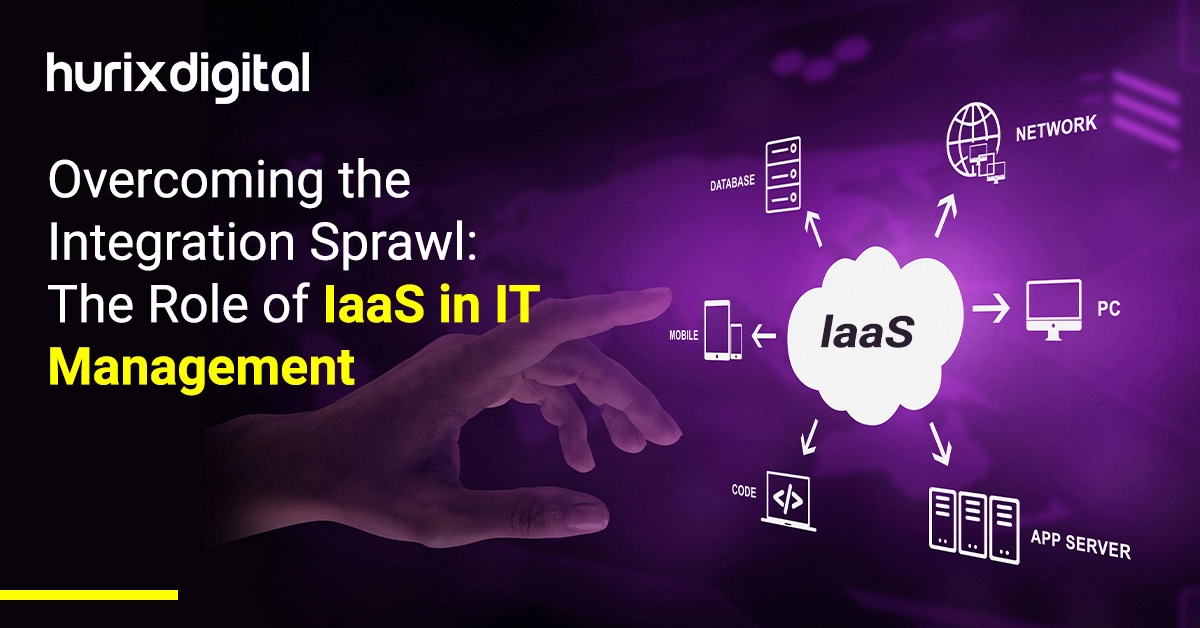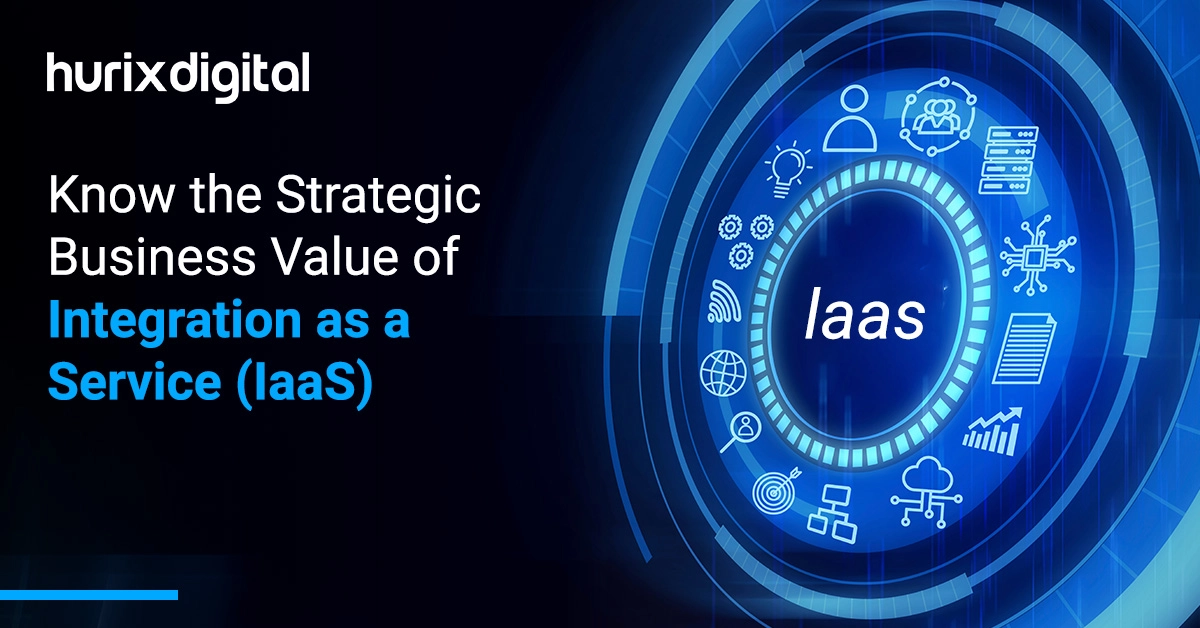
Overcoming the Integration Sprawl: The Role of IaaS in IT Management
Summary
This blog explores how Integration as a Service (IaaS) helps businesses streamline IT integrations, enhance security, simplify operations, and implement best practices in today’s digital environment.
Any integration project revolves around security; hence, IaaS companies make significant investments to guarantee that data is sent safely across systems. Many IaaS systems give companies peace of mind that their data is safeguarded by complying with industry-specific laws.
In today’s fast-changing digital environment, businesses use various applications, systems, and platforms to remain competitive. The more technologies a company uses, the more difficult it is to integrate them into a coherent ecosystem.
Often labeled as “integration sprawl,” this difficulty can cause operational complexity, data silos, and inefficiencies. Integration as a Service (IaaS) has emerged as a potent solution to these problems since it gives IT managers the tools and plans to control and simplify these integrations.
This article will explore how businesses can utilize Integration as a Service (IaaS) for IT leaders to mitigate challenges and empower teams.
Table of Contents:
- Understanding Integration as a Service (IaaS)
- Integration as a Service (IaaS) Benefits for IT Leaders
- Addressing the Challenges of Integration Sprawl
- Selecting the Best IaaS Platforms for Businesses
- Best Practices for Implementing Integration as a Service
- Wrapping Up
Understanding Integration as a Service (IaaS)
Integration as a Service (IaaS) is a cloud-based approach that seamlessly connects different systems, applications, and data sources. Unlike conventional IT infrastructure, IaaS automates and streamlines the integration process, which demands significant manual effort and equipment.
The demand for flawless integration has developed in line with the explosion of cloud-based products and services. A lack of a consistent integration plan can result in disconnected processes, data discrepancies, and operational inefficiencies.
IaaS was created to meet these challenges by providing a scalable, adaptable, and safe platform that combines several business applications, such as CRM, ERP, and marketing automation tools.
Also Read: The Ultimate Guide to Custom Software Development for Small Businesses!
Integration as a Service (IaaS) Benefits for IT Leaders
Adopting IaaS provides many advantages to IT leaders, such as simplified IT operations. Here are some of its significant benefits:
1. Streamlined Integration Management
One of the main benefits of IaaS is its capacity to automate and centralize integration administration. IT managers can monitor and manage all integrations from a single dashboard, lowering the complexity and effort needed to keep these relationships strong.
2. Simplified IT Operations
Businesses can lighten the load on their IT departments by contracting the integration process to specialist vendors. IaaS handles the technical side of integration so that IT departments may concentrate on more strategic projects.
3. Cost-Effective Solutions
Usually running on a subscription-based model, companies pay only for the IaaS services they consume. This approach guarantees that businesses may increase their integration capacity as needed without overspending, lowering initial expenses.
4. Enhanced Security and Compliance
Any integration project revolves around security; hence, IaaS companies invest significantly to guarantee data security across systems. Many IaaS systems also ensure data is safeguarded by complying with industry-specific laws.
Addressing the Challenges of Integration Sprawl
Among the many difficulties that integration sprawl can bring about are data silos, duplicate procedures, and higher running expenses. But by using the following techniques, IT managers can successfully minimize these problems:
1. Centralized Data Management
IaaS systems enable companies to connect all systems and applications, thereby dismantling data silos. Offering a whole picture of the company’s operations not only increases data accessibility but also helps in decision-making.
2. Automation of Repetitive Tasks
Many IaaS systems use automation tools to replace human involvement in data movement operations. This not only reduces the risk of mistakes, but it also gives IT staff important time-free will.
3. Real-Time Data Synchronization
Real-time data processing is indispensable in the fast-paced corporate climate. IaaS helps companies react effectively to changes by enabling data flow between systems.
4. Reduced Complexity
As companies expand, so does the complexity of their IT environments. By combining several systems via a single IaaS platform, IT managers can simplify processes, lowering the chance of mistakes and improving efficiency.
Selecting the Best IaaS Platforms for Businesses
Selecting the correct IaaS platform is critical for maximizing the benefits of integration and meeting your company’s specific demands. These important elements should help you choose an IaaS vendor:
1. Security and Compliance
Security should be the first concern, considering the delicate nature of the merging data. Search for IaaS companies that comply with pertinent industry standards such as GDPR, HIPAA, or PCI DSS, provide strong encryption, multi-factor authentication, or both. Providers with a strong background in data security and privacy are preferable.
2. Scalability
Your integration system should adapt to your company’s needs. Ensure the IaaS supplier provides scalable solutions your company may need to expand into. This covers the capacity to manage growing data volumes and the adaptability to link with newly acquired apps as they are implemented.
3. Performance and Reliability
The performance and dependability of the IaaS platform will mostly determine the success of your integrations. Seek vendors with strong disaster recovery skills, low latency, and high uptime. Regular performance monitoring and optimization should also be part of the service offering.
4. Ease of Use and Implementation
A complicated integration process can negate many of IaaS’s advantages. Selecting a provider with pre-built connectors, a user-friendly interface, and simple tools helps streamline integration implementation and management.
Furthermore, a well-documented API and robust technical support are crucial during integration.
5. Cost-Effectiveness
Consider the IaaS provider’s pricing and choose a service whose clear, adaptable pricing approach fits your budget and usage pattern. Subscription-based arrangements, whereby you pay for what you use, usually offer the best value.
6. Support and Service Level Agreements (SLAs)
Seek out companies that offer complete assistance, including technical knowledge, 24/7 availability, and quick problem resolution. Review the service level agreements (SLAs) to ensure the provider promises the performance and dependability your company needs.
Best Practices for Implementing Integration as a Service
Following these recommended practices will help companies fully utilize IaaS:
1. Define Clear Objectives
Clearly define your objectives and goals for your integration plan before implementing IaaS. Knowing your goals with your integrations will help you choose the appropriate IaaS platform and guarantee that it fits your corporate needs.
2. Assess Your Current IT Environment
Carefully review your current IT setup to identify possible problems and areas for development. This evaluation will help you choose an IaaS solution suitable for your current systems and future expansion goals.
3. Engage Stakeholders
Throughout the planning and execution phase, important team members from several departments. Their advice would be much appreciated in ensuring that the selected IaaS platform satisfies every user’s need throughout the company.
4. Continuous Monitoring and Optimization
Once the IaaS platform is used, ongoing observation is crucial to spot problems and maximize performance. Review the integration systems often to ensure they operate as planned and make any changes.
5. Focus on Security
Given data security’s relevance in integrations, ensure the selected IaaS platform provides strong security features, including encryption, multi-factor authentication, and industry compliance with standards.
Also Read: 6 Benefits of Hiring a Full-Stack Development Company to Improve Your Business
Wrapping Up
Integration as a Service empowers IT leaders with a centralized, automated, and safe platform for managing challenging integrations. By streamlining, IaaS helps companies solve integration sprawl, simplify their IT operations, and concentrate on innovation and expansion.
Integration as a Service is a strategic enabler that can change how businesses run in the digital age for IT professionals trying to stay ahead in a competitive market. IaaS provides the tools you need to reach your objectives, whether your needs are for improved data flow, automated processes, or industry regulatory compliance.
Hurix Digital prioritizes the development of accessible online platforms. Our professionals specialize in combining cloud-managed solutions to guarantee an outstanding user experience.
Get in touch today to learn how IaaS can help your business.

Currently serving as the Vice President of Technology Delivery Operations at HurixDigital, a prominent global provider of digital content and technology solutions for publishers, corporations, and educational institutions. With over 16 years of experience spanning EdTech and various domains, I hold certification as a SCRUM Product Owner (CSPO). My expertise includes operations, finance, and adept people management skills.




